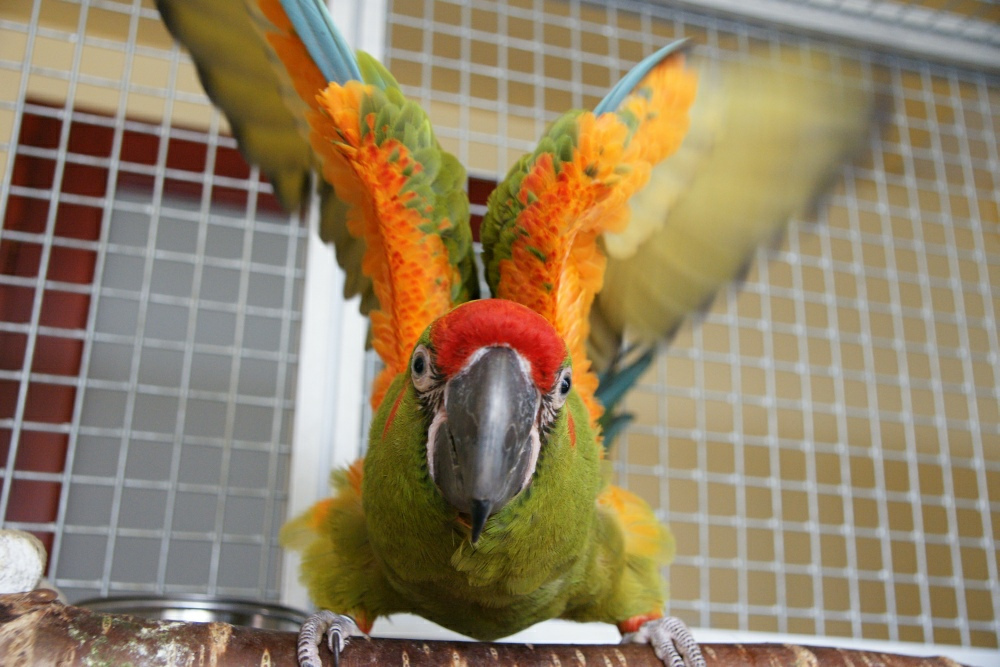
Red-fronted macaw(Ara rubrogenys)
Phylum —chordata
Class — aves
Order — psittaciformes
Family — psittacidae
Genus – ara
Appearance
The Red-fronted macaw is 55–60 cm (21.5–23.5 in) long. It is mostly green, and has a red forehead, a red patch over the ears and bright red to orange edged under wing coverts. It has an area of pinkish skin around the eyes extending to the beak. It has red at the bend of wings and blue primary wing feathers.
Habitat
Red-fronted macaws are endemic to the arid valleys of south-central Bolivia, South America. They range from south Cochabamba and west Santa Cruz through north Chuquisaca to north-east Potosí in Bolivia. The largest populations of Red-fronted macaws are in the valleys of Ríos Grande, Mizque and Pilcomayo.
Behavior
Red-fronted macaws are social and rarely found alone. They are often seen flying in small groups of 3 to 5 individuals. For most activities such as foraging or roosting they congregate in larger groups of 2 to 30. Resting often occurs during the middle of the day, during the hottest hours. Activity level is largely dependent on the age and number of individuals in the flock. Activity level increases in larger or younger flocks. Younger flocks are also much more vocal. They generally keep close to nesting sites, flying up and down the cliffs and drainage areas around the valley. While sitting in groups Red-fronted macaws are reported to exhibit four different play patterns. These patterns include pecking at each other, beak wrestling and fencing, alternating jerks of the body while on branches, and tossing objects.
Diet
Red-fronted macaws mostly feed on vegetation, vegetables, fruit and nuts. Fruits of trees such as Jatropha hieronymii are the main source of nutrition. Most grasses found in the Bolivia valleys are also consumed. Cacti (Cereus) are included in the diet and serve as a source of both food and water in their arid habitat. Like many macaws, they often chew on sticks or tree bark.
Reproduction
Red-fronted macaws form monogamous pair-bonds that are maintained year-round. Even outside of the breeding season, copulation and preening occur exclusively between pairs presumably to maintain their bond. Pairs also exhibit caressing behaviors defined by nibbling face feathers or grasping beaks. Since both the male and female are similar in color and size, sexual dimorphism is not the basis of mate selection.
Red-fronted macaws breed once a year between October and March. They nest in cavities on angled cliff sides of narrow, rocky gorges. Nests are comprised mainly of sandstone. They lay 1 to 3 eggs per season and incubation is around 26 days. Observations have shown that both parents tend the nest, but time spent in the nest varies in each pair. After young hatch, parents spend most of their time in the nest. Post-fledging, juveniles join a flock with their parents. Many social activities occur within the flock, but the majority of interactions occur within members of the same 'family' (parent-parent, parent-juvenile, juvenile-juvenile).
Red-fronted macaws may live up to 50 years.
In captivity
Red fronted macaws are one of the hardiest in their family. They are praised for their ability to adapt quickly and their robust health. Just make sure the conditions are optimal – no draft, no cold temperatures or extreme heat. Provide a lot of sunlight and a lot of room to move freely. Regular baths are a great way to keep up good hygiene and prevent any diseases. Plus, these macaws love bathing and goofing around in the shower!
In the wild, their diet is made up of a variety of fruits, nuts, seeds and agricultural crops. The first part of their diet as a pet should be the commercial seed mix for macaws. It has a good portion of millet, sunflower, and other seeds. As an important addition of vitamins and proteins, you’ll have to add plenty of fresh fruits and green vegetables. A cuttlebone is an excellent choice for added calcium and a chance for your pet to blunt their powerful beak.
Affectionate, docile, inquisitive and playful, these macaws have all the desirable traits you would want in a pet parrot. Make sure you don’t neglect their need for social interaction and play. Whether it is cuddling or goofing around the house, you will need to leave some time for your pet as well.
 Russian
Russian
 English
English























